Similar presentations:
Transactions and database integrity
1. Transactions and database integrity
TRANSACTIONS ANDDATABASE INTEGRITY
Module 3 : Database Operation
2. Test questions 1
en:ru:
1. Definition and purpose of
transactions.
1. Определение и назначение
транзакций.
2. Свойства транзакций.
3. Опишите проблемы
параллельной работы
транзакций:
2. Transaction properties.
3. Describe transaction
concurrency issues:
• loss update
• dirty reading
• inconsistent analysis
• потеря результатов обновления
• чтение "грязных" данных
• несовместимый анализ
2
3. Contents:
1.The concept of transaction
2.
Transaction properties and commands
3.
Transaction mix and launch schedule
4.
Transaction Concurrency Issues
5.
Methods for Solving Transaction Concurrency Issues
6.
Transactions and data recovery
4. The concept of transaction
1. The concept of transaction• Transaction is an indivisible sequence of data manipulation
operations in terms of the impact on the database.
A logical unit of work:
For the user, the transaction is performed on the principle of "all or
nothing": :
• or the whole transaction is executed and transfers the database
from one integral state to new integral state,
•or, if one of the transaction actions is not feasible, or any system
malfunction has occurred, the database returns to its original
state, which was before the start of the transaction (the
transaction is rolled back).
• Inside the transaction, integrity may be compromised.
4
5.
Roll back:Transactions are units of data recovery after failures - during
recovery, the system eliminates traces of transactions that could
not be completed normally as a result of a software or hardware
failure.
Concurrency:
In multiuser systems, in addition, transactions serve to ensure the
isolated work of users - users who simultaneously work with the
same database, it seems that they work as if in a single-user system
and do not interfere with each other.
Transactions provide system Stability and Predictability
5
6. 2. Transaction properties and commands
ACID Properties:(A) Atomicity . A transaction is done as an atomic operation - either the
entire transaction is performed, or it is not being fully executed.
(C) Consistency . A transaction transfers the database from one
consistent (integral) state to another consistent (integral) state.
(I) Isolation. A transactions of different users should not interfere with
each other (for example, as if they were executed strictly by one by
one).
(D) Durability. If the transaction is completed, then the results of its
work should be saved in the database, even if the system crashes at
the next moment.
6
7. Base integrity violation example
Inserting a new employee into the table does not can be performed in oneoperation. When you insert a new employee, you need to increase the value of
the field at the same time DeptQty:
Step 1. Insert an employee into the table
PERSON: INSERT INTO PERSON (6, ‘Milov’, 2)
Step 2. Increase the value of the field DeptQty:
UPDATE DEPART SET DeptQty = DeptQty + 1 WHERE DeptId = 2
If, after performing the first operation and before performing the second, the
system crashes, then only the first operation will actually be performed, and
the database will remain in a non-integral state.
Person
Depart
DeptId
DeptName
DeptQty
1
Programming department
2
2
Security department
1
PersId
1
2
3
PersName DeptId
Ivanov
1
Petrov
2
Sidorov
1
7
8. Transactions and SQL
The transaction starts automatically from the moment the user joins thedatabase and continues until one of the following events occurs:
• The command COMMIT (commit transaction) was issued.
• The ROLLBACK command was given (roll back the transaction).
• A user disconnected from the DBMS.
• There was a failure of the system.
The COMMIT command completes the current transaction and automatically
starts a new transaction. It is guaranteed that the results of the completed
transaction are recorded, i.e. stored in the database.
The ROLLBACK command rolls back all changes made by the current
transaction, i.e. canceled as if they were not at all. This automatically starts a
new transaction.
When the user is disconnected from the database, transactions are
automatically fixed.
• The BEGIN command marks the starting point of an explicit local transaction.
• The SAVEPOINT command for the current transaction sets a savepoint with
the specified name
9.
3. Transaction mix and launch scheduleA transaction is considered as a sequence of elementary atomic operations.
The atomicity of a single elementary operation is that the DBMS ensures
that, from the point of view of the user, two conditions are met:
• This operation will be performed completely or not at all (atomicity - all or
nothing).
• During this operation, no other operations of other transactions are
performed (isolation is a strict sequence of elementary operations).
In reality, the elementary operations of various transactions can be
performed in random order. For example, there are several concurrent
transactions consisting of a sequence of elementary operations.
Transaction mix
9
10.
Launch scheduleDefinition 1. A set of several transactions whose elementary
operations alternate with each other is called a transaction mix .
Definition 2. The sequence in which the elementary operations of a
given set of transactions are performed is called the launch schedule
for the transaction mix.
Note. For a given set of transactions, there can be several (generally
speaking, quite a lot) different launch schedules.
• Ensuring user isolation is reduced to choosing an appropriate
transaction launch schedule.
Definition 3. A schedule for launching a set of transactions is called a
serial schedule if transactions are performed strictly in turn, that is,
elementary transactions are not alternated with each other.
Definition 4. If a schedule for starting a set of transactions contains
alternating elementary transactions of transactions, then this
schedule is called nonserial schedule (interleaving).
10
11. 4. Transaction Concurrency Issues
How can transactions of different users interfere with eachother?
There are three main problems of concurrency:
• lost update
• uncommitted dependency (dirty reading)
• inconsistent analysis
Let's take a closer look at these issues.
11
12.
Designations• Consider two transactions A and B, starting in accordance with some
schedules.
• Let transactions work with some database objects, such as table
rows.
• The operation of reading the row P will be denoted by P = P0, where
P0 is the value read.
• The operation of writing the value of P1 to the row P will be
denoted by P1 -> P.
12
13.
Lost update problem• Two transactions take turns writing some data on the same row and
committing the changes.
Transaction A
Read P = P0
--Write P1 → P
--Commit
--Lost update result
Time
t1
t2
t3
t4
t5
t6
Transaction B
--Read P = P0
--Write P2 → P
--Commit
Result. After both transactions are completed, row P contains the value P2,
obtained by the later transaction B. Transaction A knows nothing about the
existence of transaction B and, naturally, expects row P to contain the value
P1. Thus, transaction A lost the results of its work.
13
14.
Uncommitted dependency(dirty reading)
Transaction B modifies the data in the row. After that, transaction A reads
the changed data and works with them. Transaction B rolls back and
restores old data.
Transaction A
----Read P = P1
Work with read data P1
--Commit
Work with dirty data
Time
t1
t2
t3
t4
t5
t6
Transaction B
Read P = P0
Write P1 → P
----Roll back P0 → P
---
What did transaction A work with?
14
15.
Uncommitted dependency(dirty reading)
Result. Transaction A in its work used data that is not in the
database.
Moreover, transaction A used data that was not there and was not
in the database!
Indeed, after the rollback of transaction B, the situation should be
restored, as if transaction B had never been executed at all.
Thus, the results of transaction A are incorrect, because it worked
with data that was not in the database.
15
16.
The problem of incompatible analysis• Unrepeatable reading.
• Fictitious elements (phantoms).
• Actually incompatible analysis.
16
17.
Unrepeatable readingTransaction A reads the same row twice. Between these
readings, transaction B wedges in, which changes the values in
the row.
Transaction A
Read P = P0
------Second Read P = P1
Commit
Unrepeatable reading
Time
t1
t2
t3
t4
t5
t6
Transaction B
--Read P = P0
Write P1 → P
Commit
-----
17
18.
Unrepeatable readingTransaction A knows nothing about the existence of transaction
B, and since it does not change the value in the row, it expects
the value to be the same after a second read.
Result. Transaction A works with data that, from the point of
view of transaction A, changes spontaneously.
18
19.
Fictitious elements (phantoms)Transaction A selects rows with the same conditions twice. Transaction B wedges
between samples, adds a new row that satisfies the selection condition.
Transaction A
Time
Transaction B
Selection of rows satisfying condition a
(n rows selected)
t1
---
---
t2
---
t3
Insert a new row that
satisfies condition a
Commit
Selection of rows satisfying condition a
(n+1 rows selected)
t4
---
Commit
t5
---
Rows that didn't exist before appear
Transaction A knows nothing about the existence of transaction B, and since it
itself does not change anything in the database, it expects that the same rows
will be selected after reselecting.
Result. Transaction A in two identical row samples received different results.
19
20.
Actually incompatible analysisThe mixture contains two transactions - one long, the other short.
A long transaction performs some analysis throughout the table, for example,
calculates the total amount of money on the bank accounts for the chief
accountant. Let all accounts have the same amount, for example, $100. A short
transaction at this point transfers $50 from one account to another, so the total
amount for all accounts does not change.
Transaction A
Time
Transaction B
Read account P1 = 100 and summing.
t1
--Sum = 100
t2
Withdraw money from P3 account.
--P3: 100 → 50
t3
Putting money into P1 account.
--P1: 100 → 150
--t4
Commit
Read account P2 = 100 and summing.
t5
--Sum = 200
Read account P3 = 50 and summing.
t6
--Sum = 250
Commit
t7
--The total amount of $250 is incorrect –
20
should be $300
21.
Actually incompatible analysisResult. Although transaction B did everything right - the money
was transferred without loss, but as a result, transaction A
calculated the wrong total amount.
Since money transfer operations are usually continuous, in this
situation it should be expected that the chief accountant will
never know how much money is in the bank.
21
22.
Competing transactionsAn analysis of the problems of concurrency shows that
if no special measures are taken, then when working in a
mixture, the property (I) of the transaction is insulated.
Transactions really prevent each other from getting the
right results.
However, not all transactions interfere with each
other. Transactions do not interfere with each other if
they turn to different data or run in different times.
Definition. Transactions are called Competing, if they
intersect over time and turn to the same data.
23.
Conflicts between transactions• As a result of competition for data between transactions, there is a Access
conflicts To the data:
• W-W (Write - Write). The first transaction changed the object and did not end
there. The second transaction tries to change this object.
Result. Lost update.
• R-W (Read - Write). The first transaction read the object and did not end. The
second transaction tries to change this object.
Result. Inconsistent analysis (unrepeatable reading).
• W-R (Write - Read). The first transaction changed the object and did not end
there. The second transaction tries to read this object.
Result. Dirty reading.
R-R (Read - Read) .There are no conflicts, because reading data does not
change.
24. Test questions1
en:ru:
1. Definition and purpose of
transactions.
1. Определение и назначение
транзакций.
2. Свойства транзакций.
3. Опишите проблемы
параллельной работы
транзакций:
2. Transaction properties.
3. Describe transaction
concurrency issues:
• loss update
• dirty reading
• inconsistent analysis
• потеря результатов обновления
• чтение "грязных" данных
• несовместимый анализ
24
25. Test questions2
en:ru:
1. Describe ways to solve
transaction concurrency
issues using locks.
1. Опишите способы решеня
проблем параллельной работы
транзакций с использованием
блокировок.
2. Describe the algorithm for
recovering a database after a
mild failure.
2. Опишите алгоритм
восстановления базы данных
после мягкого сбоя.
25
26. Methods for Solving Transaction Concurrency Issues
METHODS FOR SOLVINGTRANSACTION
CONCURRENCY ISSUES
27.
How to resolve competitionSince transactions do not interfere with each other if they access
different data or are executed at different times, there are two ways to
allow competition between transactions arriving at arbitrary moments:
1. “Slow down” some incoming transactions as much as necessary to
ensure the correct combination of transactions at each moment in time
(that is, to ensure that competing transactions are executed at
different times).
2. Provide competing transactions with different data instances (i.e.
make sure that competing transactions work with different versions of
the data).
The first method - "slowing down" transactions - is implemented using
various types of locks or the timestamp method.
The second method - "providing different versions of the data" - is
implemented using data from the transaction log.
28.
LocksThere are two types of locks:
Exclusive locks (X-locks) - locks without mutual access (write lock).
Shared locks (S-locks) - mutual access locks (read lock).
If transaction A locks an object using X-lock, then any access to this
object from other transactions is rejected.
If transaction A locks the object using S-lock, then:
• requests from other transactions for X-lock of this object is rejected,
• requests from other transactions for the S-lock of this object is
accepted.
Transaction B is trying to lock:
Transaction A has locked: S-Lock
X-lock
S-Lock
Yes
NO (Conflict R-W)
X-lock
NO (Conflict W-R)
NO (Conflict W-W)
28
29.
Data access protocolBefore reading an object, a transaction must impose an S-lock on
this object.
Before updating the object, the transaction must impose an Xlock on this object. If the transaction has already locked the
object using S-lock (for reading), then before updating the object,
the S-lock should be replaced with an X-lock.
If object lock by transaction B is rejected because the object is
already locked by transaction A, then transaction B enters a wait
state. Transaction B will be waiting until transaction A unlocks
the object.
X-locks imposed by transaction A are retained until the end of
transaction A.
29
30.
Solving transaction concurrency issuesLoss update problem
Two transactions take turns writing some data on the same row and
committing the changes.
Transaction A
S-lock P - successful
Read P = P0
----X-lock P - rejected
Waiting …
Waiting …
Waiting …
Time
t1
t2
t3
t4
t5
t6
T7
Transaction B
----S-lock P - successful
Read P = P0
--X-lock P - rejected
Waiting …
Waiting …
Result. Both transactions are waiting for each other and cannot continue.
There was a deadlock situation.
30
31.
Uncommitted dependency problem(dirty reading)
Transaction B modifies the data in the row. After that, transaction A reads the
changed data and works with them. Transaction B rolls back and restores old data.
Transaction A
--------S-lock P - rejected
Time
Transaction B
t1
S-lock P - successful
t2
Read P = P0
t3
X-lock P - successful
t4
Write P1 → P
t5
--t6
Rollback P0 → P
Waiting …
(Unlock P)
S-lock P - successful
T7
--Read P = P0
T8
--Work with read data P0 T9
----Commit
OK
T10
T11
-----
Result.
Problem resolved
31
32.
Unrepeatable readingTransaction A reads the same row twice. Between these readings,
transaction B wedges in, which changes the values in the row.
Transaction A
S-lock P – successful
Read P = P0
----Second Read P = P0
Commit
(Unlock P)
------OK
Time
t1
t2
t3
t4
t5
t6
T7
T8
T9
Transaction B
----X-lock P – rejected
Waiting …
Waiting …
Waiting …
X-lock P – successful
Write P1 → P
Result.
Commit
Problem resolved
(Unlock P)
32
33.
The problem of incompatible analysisFictitious elements (phantoms)
Transaction A selects rows with the same conditions twice. Transaction B wedges
between samples, adds a new row that satisfies the selection condition.
Transaction A
S-lock rows satisfying condition a
(n rows locked)
Selection of rows satisfying
condition a
(n rows selected)
---
Time
t1
Transaction B
---
t2
---
t3
--S-lock rows satisfying condition a
(n+1 rows locked)
t4
t5
Insert a new row that satisfies
condition a
Commit
---
Selection of rows satisfying
--t6
condition a
(n+1 rows selected)
Commit
--t7
Rows that didn't exist before
appear
Result. Row level locking didn't solve the problem of fictitious elements
33
34.
Actually incompatible analysisThe effect of the incompatible aalysis itself is also different
from previous examples in that there are two transactions in
the mix - one long, the other short.
A long transaction performs some analysis throughout the
table, for example, calculates the total amount of money on
the bank accounts for the chief accountant. Let all accounts
have the same amount, for example, $100. A short
transaction at this point transfers $50 from one account to
another, so the total amount for all accounts does not
change.
34
35.
Actually incompatible analysisTransaction A
Time
S-lock P1 - successful
t1
Read account P1 = 100 and summing.
t2
Sum = 100
Transaction B
-----
---
t3
---
t4
---
t5
X-lock P3 - successful
Withdraw money from P3 account.
P3: 100 → 50
X-lock P1 - rejected
--S-lock P2 - successful
Read account P2 = 100 and summing.
Sum = 200
S-lock P3 - rejected
Waiting …
t6
t7
Waiting …
Waiting …
t8
Waiting …
t9
t10
Waiting …
Waiting …
Result. Both transactions are waiting for each other and cannot continue.
There was a deadlock situation.
35
36.
Problem analysis• Loss update problem - There was a deadlock situation.
• Uncommitted dependency problem (dirty reading) -
Problem resolved.
• Unrepeatable reading problem - Problem resolved.
• The appearance of fictitious elements - Problem was not
solved.
• The problem of incompatible analysis - There was a
deadlock situation.
36
37.
General view of the dead lockTransaction A
Lock object P1 – successful
--
Time
t1
t2
Transaction B
--Lock object P2 – successful
P2 object lock conflicts with a
lock imposed by transaction A
t3
---
Waiting …
t4
Waiting …
Waiting …
t5
P1 object lock conflicts with a
lock imposed by transaction A
Waiting …
Waiting …
Because there is no normal way out of the deadlock situation, then such a
situation needs to be recognized and eliminated. A method for resolving a
deadlock situation is to roll back one of the transactions (victim transaction)
so that other transactions continue their work. After resolving the deadlock,
the transaction selected as the victim can be repeated again.
37
38.
Two approaches for choosing a victim1.
The DBMS does not monitor the occurrence of deadlocks. Transactions
themselves decide whether to be their victim.
2.
The DBMS itself monitors the occurrence of a deadlock situation, it also
decides which transaction will be the victim.
Resolving the remaining problems
The remaining problems, in particular phantoms, are solved by blocking an
object of a larger size than the lines.
For example, locking at the column level, multiple rows, tables, databases.
When blocking large database objects, there are fewer opportunities for
parallel transactions..
When using locks of objects of different sizes, the problem of detecting already
imposed locks arises. If transaction A is trying to lock the table, then you need to
have information if there are already locks at the row level of this table that are
incompatible with table locking.
To solve this problem, the intentional locking protocol is used, which is an
extension of the data access protocol. The essence of this protocol is that before
imposing a lock on an object (for example, on a row in a table), it is necessary to
impose a special intentional lock (intent lock) on objects that include a locked
object.
38
39. Two-phase transaction confirmation
In distributed systems, committing transactions may require the interaction ofseveral processes on different machines, each of which stores some variables, files,
databases. To achieve the indivisibility of transactions in distributed systems, a
special protocol is used called the two-phase transaction fixing protocol.
Although it is not the only protocol of its kind, it is most widely used.
In the first phase, one of the processes acts as a coordinator. The coordinator
starts the transaction by recording this in his logbook, then he sends to all
subordinate processes that are also performing this transaction a message
“Prepare for commit”. When subordinate processes receive this message, they
check to see if they are ready for committing, make an entry in their log and send
the coordinator a response message “Ready for commit”. After that, the
subordinate processes remain in a ready state and wait for the commit command
from the coordinator. If at least one of the subordinate processes has not
responded, the coordinator rolls back the subordinate transactions, including
those that are prepared for fixing.
The second phase is that the coordinator sends a Commit command to all
subordinate processes. By executing this command, the latter commit the
changes and complete the subordinate transactions. As a result, simultaneous
synchronous completion (successful or unsuccessful) of a distributed transaction
is guaranteed.
40. Transactions and data recovery
TRANSACTIONS ANDDATA RECOVERY
41.
After the system fails, the subsequent launchanalyzes the transactions that were performed before
the transaction fails.
Those transactions for which the COMMIT command
was given, but whose work results were not recorded
in the database, are executed again (rolled).
Those transactions for which the COMMIT command
was not given are rolled back.
42. Data durability
• The requirement of data durability (one of the properties oftransactions) is that the data of completed transactions must be
stored in the database, even if the system crashes at the next
moment.
• The requirement of atomicity of transactions states that incomplete
or rollback transactions should not leave traces in the database. This
means that the data must be stored in the database with
redundancy, which allows you to have information from which you
can restore the state of the database at the time of the start of a
failed transaction.
• This redundancy is usually provided by the transaction log. The
transaction log contains details of all data modification operations
in the database, in particular, the old and new values of the modified
object, the system number of the transaction that modified the
object and other information..
42
43. Types of failures
• Individual transaction rollback. It can be initiated either by thetransaction itself using the ROLLBACK command, or by the system.
The DBMS can initiate a transaction rollback in case of any error in
the transaction operation (for example, division by zero) or if this
transaction is selected as a victim when resolving the deadlock.
• Mild system failure (software failure). It is characterized by the loss
of system RAM. In this case, all transactions that are performed at
the time of the failure are affected, the contents of all database
buffers are lost. Data stored on disk remains intact. A mild failure
can occur, for example, as a result of a power outage or as a result
of a fatal processor failure.
• Hard system failure (hardware failure). It is characterized by
damage to external storage media. It can occur, for example, as a
result of a breakdown of the heads of disk drives.
43
44.
Transaction logIn all three cases, the basis of recovery is the redundancy of data
provided by the transaction log.
Like database pages, data from the transaction log is not written
directly to disk, but is pre-buffered in RAM. The system
supports two types of buffers:
database page buffers,
transaction log buffers.
44
45.
LoggingDatabase pages whose contents in the buffer (in RAM) are different from
the contents on the disk are called dirty pages.
The system constantly maintains a list of dirty pages - a dirty list.
Writing dirty pages from the buffer to disk is called pushing pages into
external memory.
The basic principle of a consistent policy for pushing the log buffer and
database page buffers is that the record about the change of the database
object must fall into the external memory of the log before the changed
object is in the external memory of the database.
The corresponding logging (and buffering control) protocol is called Write
Ahead Log (WAL) - "write first to the log", and consists in the fact that if
you want to push the modified database object into external memory, you
must first ensure that the log is pushed into external memory records of
its change.
45
46.
Save checkpoint• Additional condition for pushing buffers:
Each successfully completed transaction must be actually saved in
external memory. Whatever failure occurs, the system should be able to
restore the state of the database containing the results of all
transactions committed at the time of the failure.
• The third condition for pushing buffers is:
Limited volume of database buffers and transaction logs. The system
accepts a checkpoint, which includes pushing the contents of the
database buffers into an external memory and a special physical record
of the checkpoint, which is a list of all transactions currently being
performed.
• The minimum requirement guaranteeing the possibility of restoring the
last consistent state of the database is to push all the database change
records by this transaction when the transaction is committed to the
external memory. At the same time, the last log entry made on behalf
of this transaction is a special record about the end of this transaction
46
47.
Individual transaction rollbackIn order to be able to perform an individual rollback of a transaction
in the transaction log, all log records from this transaction are
linked to the reverse list.
The beginning of the list for non-completed transactions is a record of
the last database change made by this transaction.
For completed transactions (individual rollbacks of which are no
longer possible), the beginning of the list is a record of the end of the
transaction, which is necessarily pushed into the external memory of
the log.
The end of the list is always the first record of a database change
made by this transaction. Each record has a unique transaction
system number so that you can restore a direct list of records of
database changes for this transaction.
47
48.
Individual transaction rollback (algorithm)1. A list of records made by a given transaction in the transaction log
is viewed (from the last change to the first change).
2. The next record is selected from the list of this transaction.
3. The opposite operation is performed: instead of the INSERT
operation, the corresponding DELETE operation is performed,
instead of the DELETE operation, INSERT is performed, and instead
of the direct UPDATE operation, the inverse UPDATE operation
restores the previous state of the database object.
4. Any of these reverse operations are also logged. This must be
done, because during the execution of an individual rollback, a mild
failure may occur, during recovery after which it will be necessary to
roll back a transaction for which an individual rollback has not been
fully completed.
5. Upon successful completion of the rollback, a record of the end of
the transaction is logged.
48
49.
Recovering from a mild failure• After a mild failure, not all physical database pages contain
changed data, because not all dirty database pages were
pushed to external memory.
• The last moment when the dirty pages were guaranteed to be
pushed out is the moment of the adoption of the last
checkpoint. There are 5 options for the state of transactions
with respect to the time of the last checkpoint and the time of
failure:
49
50.
Recovering from a mild failureTime
tc
tf
No action
Repeat partially
Rollback partially
Repeat fully
No action
Checkpoint
Failure
50
51.
Recovering from a mild failureThe last checkpoint was taken at time tc. A mild system failure occurred at
time tf. Transactions T1-T5 are characterized by the following properties:
T1. The transaction completed successfully before the adoption of the
checkpoint. All data of this transaction is stored in long-term memory both log records and data pages changed by this transaction. Transaction T1
does not require any recovery operations.
T2 . The transaction started before the adoption of checkpoint and
successfully completed after the checkpoint, but before the failure. The
transaction log records related to this transaction are pushed to external
memory. Data pages modified by this transaction are only partially pushed
into external memory. For this transaction, it is necessary to repeat again
the operations that were performed after the adoption of the
checkpoint.
• T3. The transaction started before the adoption of the checkpoint and
was not completed as a result of the failure. Such a transaction must be
rolled back. The problem, however, is that some of the data pages
modified by this transaction are already contained in the external memory
- these are the pages that were updated before the adoption of the
checkpoint. There are no traces of changes made after the checkpoint in
the database. Transaction log entries made prior to the adoption of the
checkpoint are pushed to external memory, those log records that were
made after the checkpoint are not in the external memory of the log.
51
52.
Recovering from a mild failureT4. The transaction started after the adoption of the checkpoint and
successfully completed before the system failure. The transaction log
records related to this transaction are pushed into the external log memory.
Changes to the database made by this transaction are completely absent in
the external memory of the database. This transaction must be repeated in
its entirety.
T5 . The transaction started after the adoption of the checkpoint and was
not completed as a result of the failure. There are no traces of this
transaction either in the external memory of the transaction log, or in the
external memory of the database. For such a transaction, no action needs to
be taken, as if it did not exist at all.
System recovery after a mild failure is performed as part of the system
reboot procedure. When the system is rebooted,
• transactions T2 and T4 - must be partially or completely repeated,
transaction T3 is partially rolled back,
no action is required for transactions T1 and T5.
52
53.
Recovering from a hard system failure• If a hard failure occurs, the database on the disk is physically disrupted.
The basis of recovery in this case is the transaction log and an archive copy
of the database. An archive copy of the database should be created
periodically taking into account the speed of filling the transaction log.
• Recovery begins with backing up the database from the archive copy.
Then, a transaction log is reviewed to identify all transactions that
completed successfully before the failure. (Transactions ending with
rollback before the failure can not be considered). After that, the
transaction log in the forward direction repeats all successfully completed
transactions. At the same time, there is no need to roll back transactions
interrupted as a result of a failure, because the changes made by these
transactions are not available after restoring the database from the
backup.
• The worst case is when both the database and the transaction log are
physically destroyed. In this case, the only thing that can be done is to
restore the state of the database at the time of the last backup. In order to
prevent this situation from occurring, the database and the transaction log
are usually located on physically different disks managed by physically
different controllers.
53
54. Test questions2
en:ru:
1. Describe ways to solve
transaction concurrency
issues using locks.
1. Опишите способы решеня
проблем параллельной работы
транзакций с использованием
блокировок.
2. Describe the algorithm for
recovering a database after a
mild failure.
2. Опишите алгоритм
восстановления базы данных
после мягкого сбоя.
54






















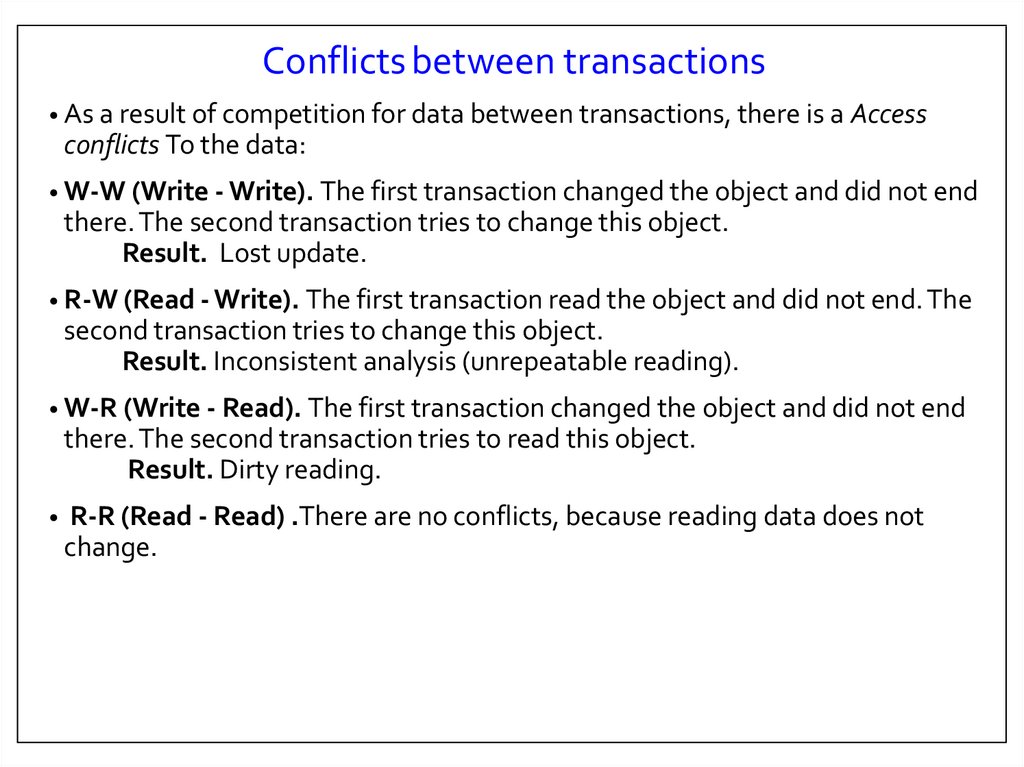






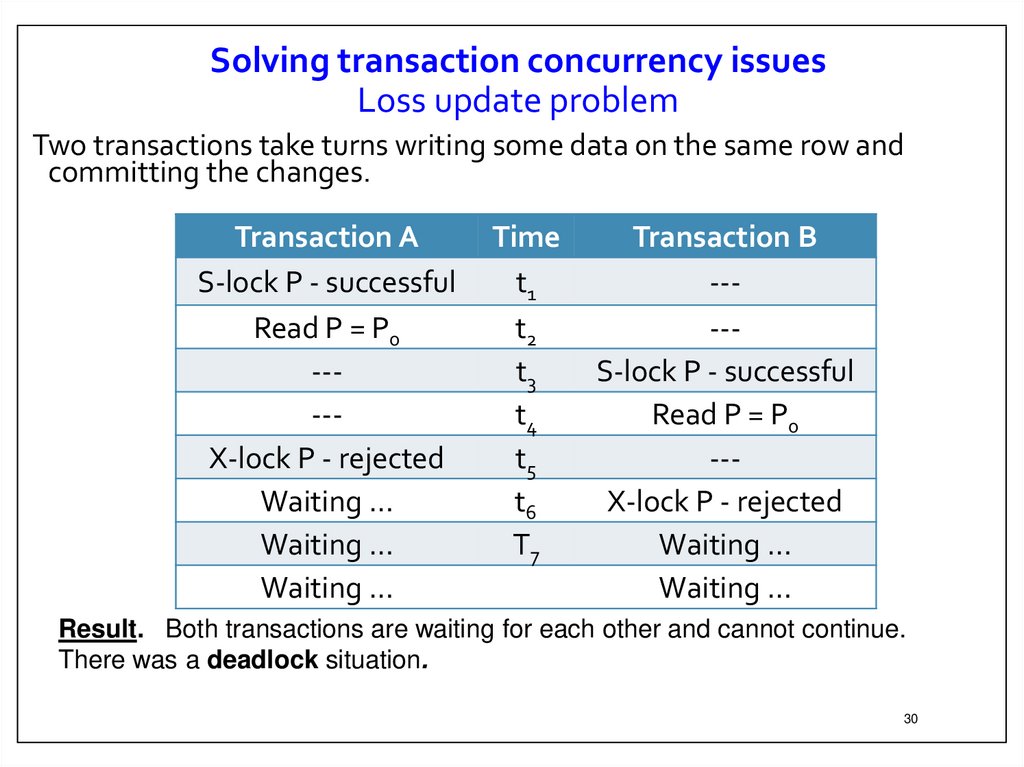

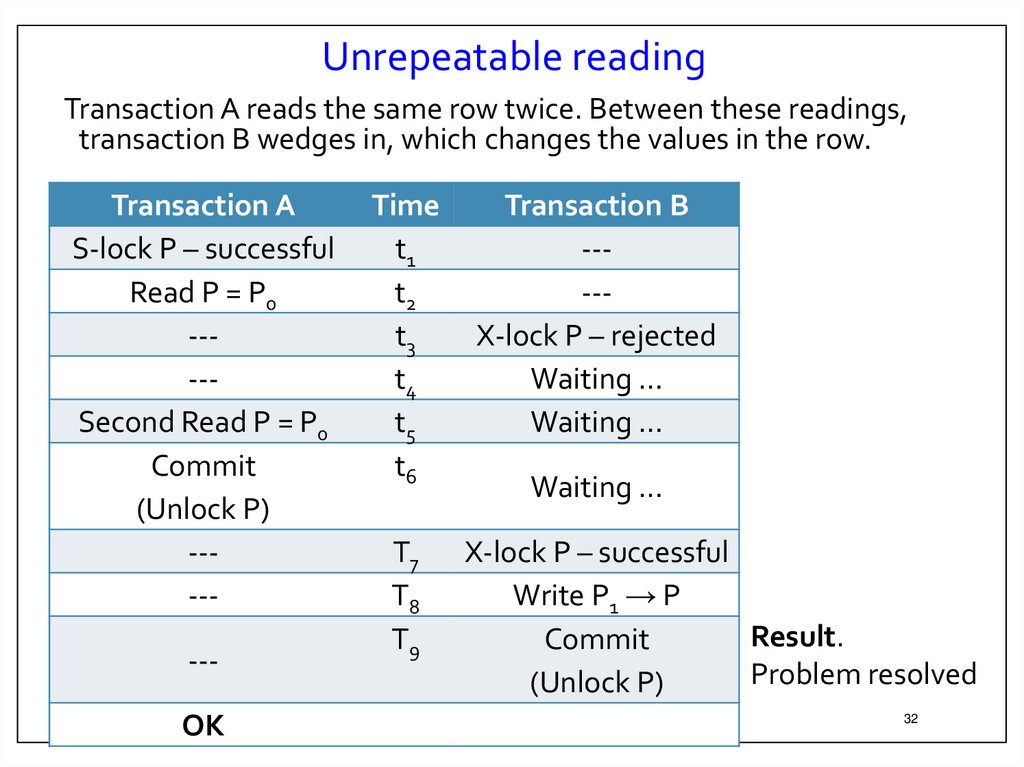













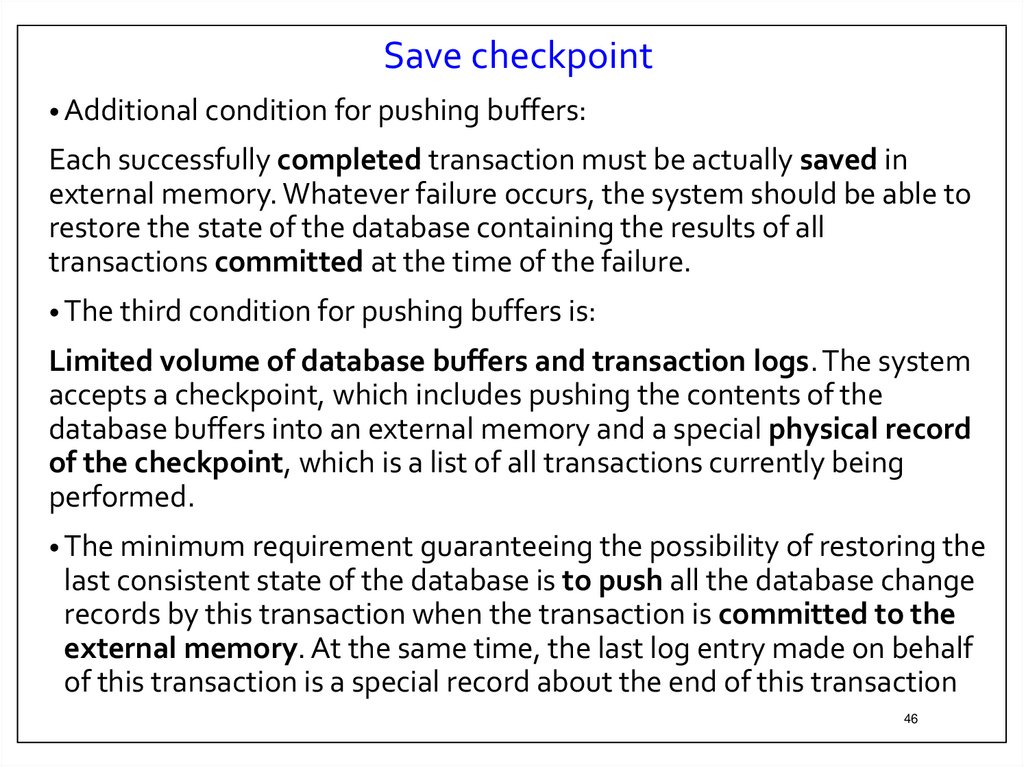


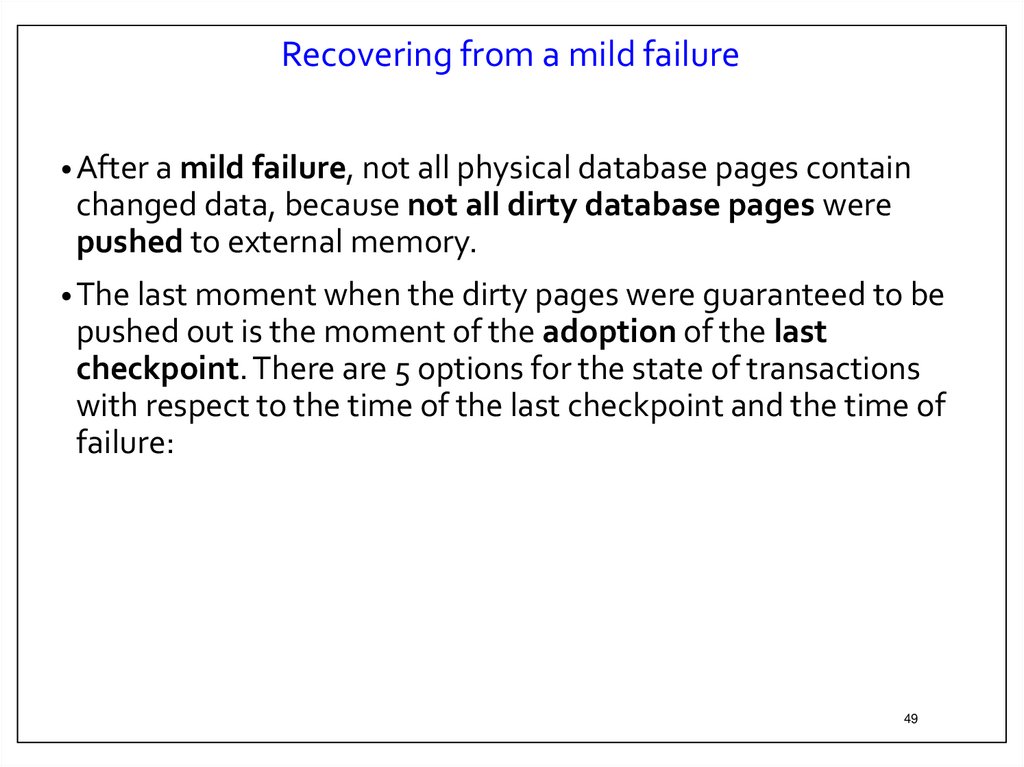


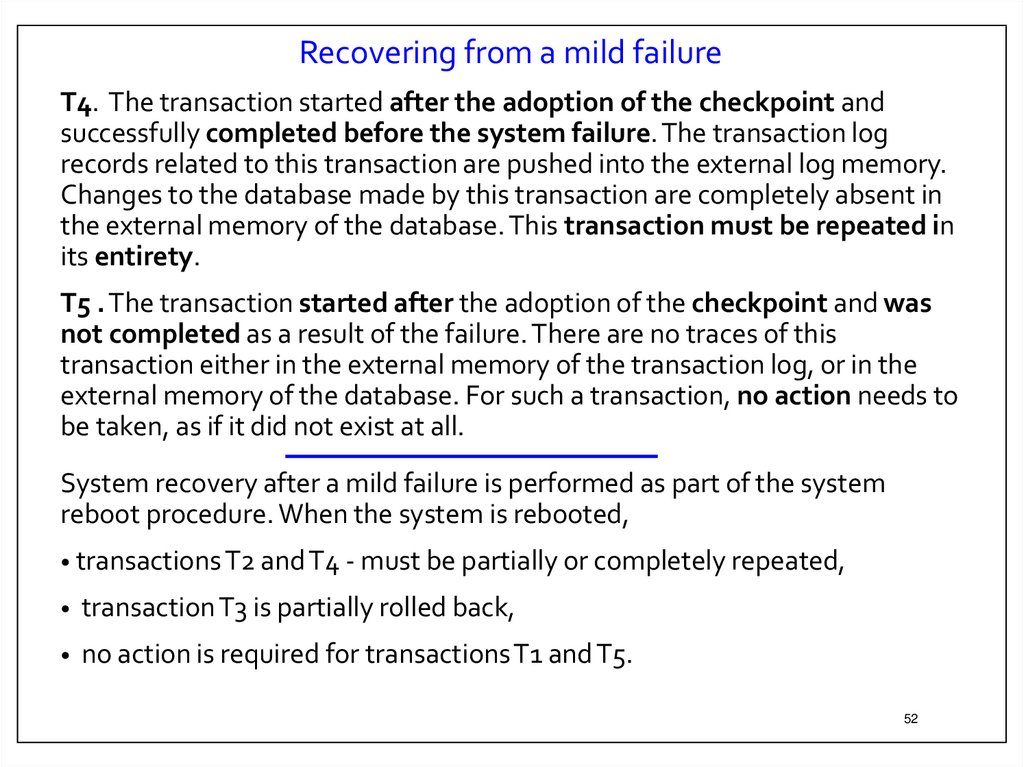



 mathematics
mathematics








